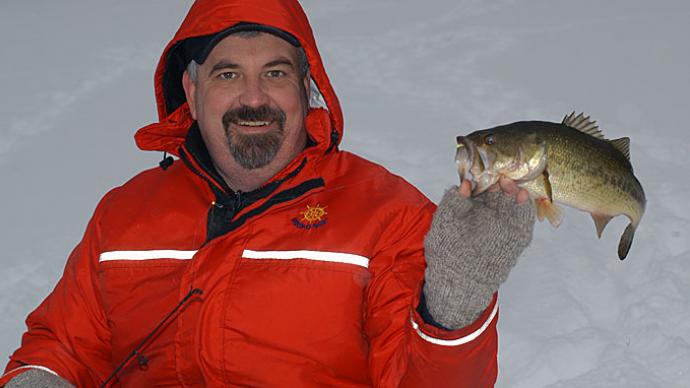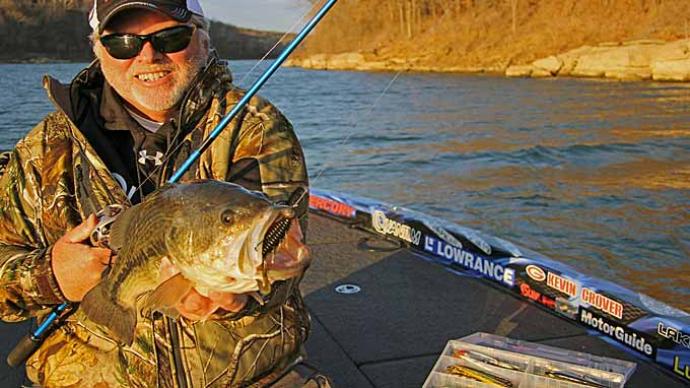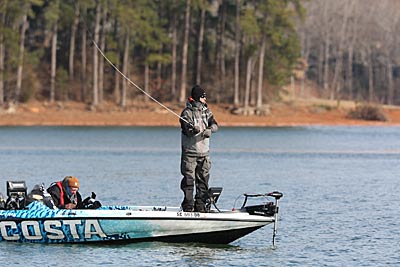
There was a time not that long ago when soft-plastic lures were reserved for warm water bass fishing. When the water temperature dropped, anglers pulled out spoons, blade baits, and jigs — living rubber and hair — sporting salty pork-rind frogs. They believed that soft plastics lost their fish-attracting action in cold water and lacked the taste and scent that bass wanted.
Times have changed. High-tech materials, life-like shapes, and injections of salt and scent make today’s soft-plastic lures productive year-round. Even in the coldest water, Bassmaster Elite Series angler Jason Williamson has soft plastics rigged, though only certain ones. They include straight tail Zoom Trick Worms, but not any of the manufacturer’s 10 1/2-inch long Ol’ Monster ribbon-tail worms. Those he saves for summer. “It’s about matching the hatch,” he said.
Picking the best soft-plastic lure for cold water starts with where it’ll be fished. Cold water is relative. In Florida, for example, bass hunker down in thick beds of aquatic vegetation. Farther north, they lock themselves to the bottom in deep water. You also want lures that mimic important cold-water forage — baitfish and crawfish.
Stocking your tackle box with these seven soft-plastic lures will prepare you to fish until ice forms and start again as soon as it melts, if that’s the situation on your home lake, or straight through the winter if you’re blessed with open water year-round.
-
Soft-plastic jerkbaits
Image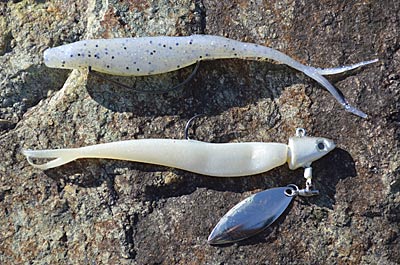
Most reservoir bass follow schools of baitfish throughout the cold-water season. Soft jerkbaits rigged Texas-style without a weight or on an underspin will catch them from the surface to the bottom. Photo by Pete M. Anderson Whether they’re swimming deep or shallow, cold-water bass eat baitfish. And one of the best ways to imitate them is with a soft-plastic jerkbait. They are sold in a variety of colors and sizes, making it easy to match current water conditions and the size of baitfish that bass are eating.
Soft-plastic jerkbaits can be rigged in several ways. Try a simple Texas rig without a weight when cold-water bass are shallow. Throwing one near surface activity, giving it a couple of quick twitches, and letting it settle is a sure way to get a bite. And in calm conditions, they are an excellent finesse option anywhere you would fish a hard-plastic or wooden jerkbait.
Threading one onto an underspin also is effective in cold water. That was proved by Major League Fishing angler Casey Ashley in 2015 when he used a homemade underspin rigged with a pearl Zoom Super Fluke Jr. to win the Bassmaster Classic on Lake Hartwell, which sits on the Georgia-South Carolina line.
Underspins can be fished throughout the water column. That makes them a perfect weapon for catching suspended bass. Count it down to the proper depth and start a slow retrieve. The combination of flashing blade and flickering tail is irresistible to cold-water bass.
-
Swimbaits
While soft-plastic jerkbaits excel when the fishing is tough, they move slowly, making them unsuited to covering water. That’s when swimbaits shine. Their slender bodies and paddle tails create a natural swimming action when steadily retrieved, even when mixing in pauses or slowing down enough, so they bounce along the bottom like a crankbait.
Image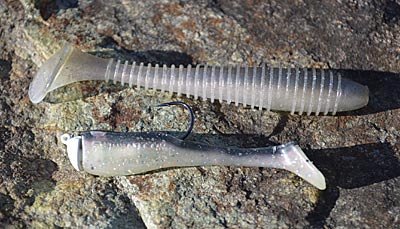
Swimbaits are a great choice when cold-water bass are feeding on baitfish. Keep it in their strike zone by adjusting your retrieve speed — faster for shallower water and slower for deeper water. Photo by Pete M. Anderson Rig them on a ball or shad-shaped jig head. Adjust the weight to your fishing depth, adding more as the water gets deeper. Jig heads weighing 1/8- or 1/4-ounce fished on a spinning rod or medium-power casting rod and 10-pound test line, for example, are perfect for up to 10 feet of water when fishing a 3- or 4-inch swimbait. If cover allows, always rig them with an open hook, which increases the likelihood of hooking lethargic cold-water bass that only swipe at your lure.
You can’t go wrong with any baitfish-colored swimbait, and translucent ones work better in clear water. And don’t be afraid to go small. There are occasions when a 2-inch swimbait will generate the most bites.
-
Grubs
If you’re choosing the poster child for soft plastics that catch bass in cold water, then the single-tail grub is your lure. Its compact size and C-shaped tail mimic a baitfish. It can be fished at all depths. Reel it slowly for suspended fish, or hop it along the bottom.
While they can be rigged weedless, stick with a jig head in cold water, usually from 1/8 to 3/8 ounce, depending on the size of the grub and the depth you are fishing. Ball heads are an excellent all-around choice, and darter-shaped heads add action to your grub, an essential trigger on slightly warmer days when cold-blooded bass take advantage of the sun’s rays.
Grubs come in various lengths, with 3- and 4-inch models favored for cold water. Choose ones with a thin tail that wiggles with even the slightest movement. Don’t overlook flat-tail grubs such as Mann’s Stingray. They dip, dive and quiver more than curly tail grubs and produce best in the coldest water.
Keep your color choices simple. Clear with silver flake, smoke with red flake, pearl, pumpkinseed, and green pumpkin will cover nearly every situation.
-
Tubes
Baitfish? Crawfish? It doesn’t matter when you are fishing a tube, which imitates both equally well. Texas rig one and flip it into hyacinth mats covering skinny for wintertime Florida largemouth. Or try twitching one through schooling spotted bass or dragging it through deep rocks for smallmouth.
A four-inch tube is the standard and the right choice for fishing cold water. Color depends on where you’re fishing. Junebug or black-and-blue, for example, are good choices when fishing in and around aquatic vegetation. Variations of smoke and pearl work best for schooling bass, and green pumpkin always catches bass around deep rock.
While a heavy bullet-shaped weight will be needed to break through thick vegetation, go with the lightest jig head you can when fishing a tube elsewhere. They give your tube a more natural look and force you to fish slowly, often the best speed for cold water. Internal ones make tubes swim more, and external ones pull them straight to the bottom.
-
Spider grubs
Spider grubs, also known as hula or skirted grubs, have been around forever. And while most bass anglers have a bag or two of them in their tackle box, they rarely receive the recognition they deserve. They offer the big-bass catching power of a traditional bass jig in a package easily tunable to the conditions.
Broken into its parts, a spider grub is a skirted collar and twin-tail grub. Most are sold molded together, but each is available in a variety of colors, both matching and contrasting. This is a crawdad imitator, so stick to natural greens and browns, switching from light to dark as the water colors go from clear to muddy.
Fish spider grubs around docks, rocks, and stretches of hard bottom. Rig them on different jig heads, from footballs that seem as big as your fist to light-wire finesse heads that weigh a mere 1/16 ounce, to enact different actions. Use a football head when dragging them across a rocky bottom. When it meets an obstruction, the jig head’s shape causes the spider grub to rock up before climbing over it. That little extra action can provoke a sluggish cold-water bass to strike. Or try a light finesse head, sending your spider grub slowly and naturally to the bottom.
-
Craws
Spider grubs aren’t the only soft-plastic lure that closely imitates crawfish in cold water. Craw worms do that, too. Most create a larger profile than a spider grub, making them a suitable choice when searching for big bass.
Craw worms, such as Larew’s Salt Craw or NetBait’s Paca Craw, can be rigged in several ways, including as a jig trailer, Texas-style, and on a heavy shaky head. While all three work well in cold water, the last is perfect for fishing around rocks of any size.
Williamson often rigs a Zoom Speed Craw on a Buckeye Sled Jig. Like on a shaky head, the craw lays parallel to the bottom, giving it a more natural appearance when dragged along the bottom. While keeping your rod tip pointed at the water, slowly slide it forward, letting the lure rest while you take up the slack. Like the spider grub, every bump your shaky head comes across makes your soft-plastic craw twitch.
Image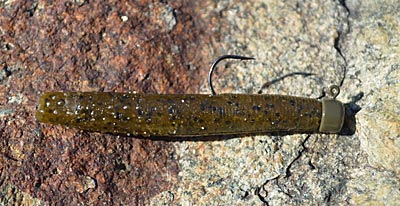
The Ned Rig isn’t flashy but resembles most baitfish and other prey that bass find along the bottom. Photo by Pete Anderson -
Ned Rig
Major League Fishing angler Mark Daniels Jr. is a big fan of the Ned Rig, the stubby piece of soft plastic that made a big splash in finesse fishing. “It doesn’t look like a lot,” he said. “I swear fish eat it up.”
Daniels proved the Ned Rig’s worth in warm water in July 2018 when he fished it to a Bassmaster Elite Series win on South Dakota’s Lake Oahe. But he also throws it in cold water. He said its compact size and subtle action are irresistible to the passive bass hugging the bottom.
Not all Ned Rigs are the same. Daniels points to Z-Man’s Finesse TRD, which looks like a 2 3/4-inch long straight piece of round soft plastic without a tail or appendages. But on closer inspection, you’ll notice it’s made from a unique plastic. ElaZtech is highly buoyant, causing a Ned Rig to stand up when it's on the bottom. That makes it more visible to bass. “That’s a big deal when it comes to getting a bite,” he said.
Daniels slowly moves his Ned Rig along the bottom with a 7-foot 1-inch medium-heavy Favorite Fishing Sick Stick spinning rod. His main line is 15-pound Seaguar Smackdown braid, and his leader is 8 feet of 8-pound test Seaguar Tatsu fluorocarbon line. And he rigs the Finesse TRD on Z-man’s Shroomz jig heads, in either 1/5 or 1/6 ounce.
BassResource may receive a portion of revenues if you make a purchase using a link above.


